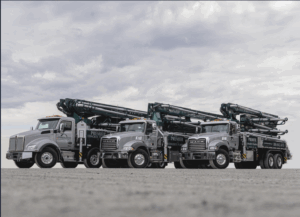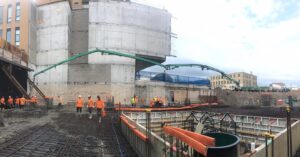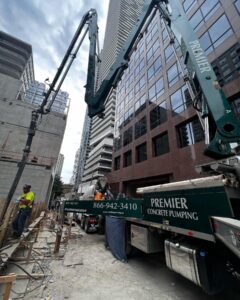Thinking about pouring a concrete floor slab? Whether it’s a shed, a basement, or a commercial pad, getting the job done right starts with the right pump and a well-prepped site. At Premier Concrete Pumping, we’ve poured thousands of slabs across Ontario — and we’ve seen it all. In this guide, we’ll walk you through what you need to know before the concrete starts flowing, what affects your project cost, and how to make sure the pour goes smooth from start to finish.
Picking the Right Pump for Your Floor Slab
Choosing a pump isn’t guesswork — it’s all about reach and site access.
When you call us to pour a floor, the first thing we ask is:
-
How many cubic meters are you pouring?
-
How big is the floor in square footage?
-
Where can we park the pump truck?
From there, we’ll recommend the right pump. If we’ve got close access, a line pump might do. For harder-to-reach areas or bigger slabs, we’ll bring in one of our boom pumps — like our 36Z, 38Z, or 40Z — to make the job safer and more efficient.
Check out our full range of boom pumps
What You Need to Prep Before We Arrive
In most cases, the general contractor or homeowner has everything ready before we show up. Here’s what a typical site needs before the pour:
-
Subfloor (gravel or crushed stone)
-
Formwork (unless it’s a basement floor using foundation walls)
-
Rebar or mesh
-
Concrete ordered and scheduled
We don’t build forms — we pump. Once your site is prepped, we bring the pump, set up, and get to work. After the pour, your finishers take over to complete the slab.
For basements, forms usually aren’t needed because the foundation walls act as the mold. In those cases, we’re simply there to pump the concrete in cleanly and efficiently.
Read more about our residential concrete pumping services
How Long Does It Take to Pour a Floor?
It depends on a few things:
-
How much concrete you’re pouring (volume in m³)
-
Which pump we’re using — every pump has a different meters/hour output
-
How fast your finishers can work
-
How fast your concrete supplier is delivering
There’s no cookie-cutter timeline. But generally, we price floor jobs by the hour, with a 4-hour minimum included in the cost. If it goes longer, it’s just our hourly rate after that.
We factor in:
-
Travel time
-
Setup
-
Pouring
-
Clean-up
This structure gives everyone peace of mind — especially when you’ve got multiple trucks of concrete rolling in.
When You Might Need More Than One Operator
Most of our pumps come with one operator, which is more than enough for standard slab pours. But there are some exceptions:
-
If you’re running over 200 feet of line, we’ll send a second operator
-
If you’re using a 52m+ boom, that also requires a second person
-
If the site has unusual access or safety requirements (e.g., near rail lines)
We’re not a two-pump operation — we’ve got the fleet to handle any size job and keep your timeline tight.
See how we handle large/remote concrete pumping projects
Safety Is Built Into Everything We Do
Every one of our operators goes through in-house safety training. That includes everything from general jobsite protocols to specialized training for job sites near railways, commercial zones, or other high-risk areas.
We also work with customers’ internal safety teams. If your site requires specific onboarding, we’ll attend your training session and follow your protocols.
It’s how we keep your jobsite (and our crew) running without hiccups.
Forming, Finishing, and Who’s Responsible for What
We don’t pour into thin air. There needs to be a structure to pour into — and that’s where forming comes in.
Here’s the usual workflow:
-
You (or your forming contractor) builds the forms
-
You book the concrete supplier
-
You call us to pump it in
-
Your finishers complete the slab
If you’re working with a forming company, they often have their own finisher and concrete supply crew. If they don’t, we’re happy to connect you with trusted contractors in your area.
What Makes a High-Quality Concrete Floor Pour?
Here are the 3 biggest things that determine how good your slab turns out:
-
How quickly your concrete is being delivered. Delays between trucks can affect the consistency of the slab.
-
The speed and experience of your finishers. If they fall behind, the concrete might need to be slowed down — costing more in time and labor.
-
A pump that matches your site. Too much hose or an underpowered pump can cause delays, mess, or even pump failure. We eliminate that risk by sending the right unit with the right crew the first time.
Never Worked With a Pump Before? No Problem.
Most of our customers are experienced in concrete, but if you’re new — don’t worry. We’ll walk you through what you need, explain how the process works, and make sure your floor slab pour goes smoothly.
We’re in the business of making your life easier. When the site is ready, we’re ready.
Need a reliable pump for your next floor slab pour?
Get in touch with Premier Concrete Pumping today →



